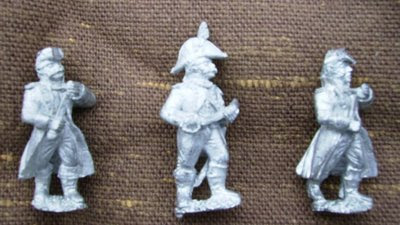 An aerial view.
An aerial view. *
*Being an account of the doings in the Grand Duchy of Hetzenberg & environs.



 An aerial view.
An aerial view. *
*
 Standard bearers with untouched officer for comparison.
Standard bearers with untouched officer for comparison. A bit blurry but this shows the shape of the modified headgear compared with the fifer on the left.
A bit blurry but this shows the shape of the modified headgear compared with the fifer on the left. The Commanding Officer and a soldier to be.
The Commanding Officer and a soldier to be. A boatman's eye view .
A boatman's eye view .
The three main components.
*
Progress is being made! All the major construction work is finished. It only remains to make the quaysides from which the bridge will spring, and I'll begin work on those this weekend using 1" blue insulation foam as a base. Once all is assembled, the bridge will be painted with Klear (Future in the US) polish to seal the plaster, followed by blocking-in the stonework with a sandy-ochre color using Crown-brand "eggshell" paint designed for use on plasterwork and wood. A small test patch can be seen on the right of the middle picture. All finer paintwork such as weathering effects, the tower sides, timbers and roofs will be done in acrylics. The interiors of the spans were painted before being fixed in place.
*
As mentioned before, all major construction was done using plaster casts made from the versatile Hirst Arts molds. The roofs are of card with the tiles cut from individual strips and the whole treated with Klear for additional strength. For ease of transport the model was built in three sections which will rise to five when the quaysides are done. This has the added benefit of allowing me to insert different central spans over time, such as a broken one showing a bridge demolition, and perhaps a Dutch-style double drawbridge to allow passage by masted vessels. The figures posing on the bridge are natives from my Daftest Africa campaign world awaiting their basework.
 One advantage to getting some half-painted figures - less work to do! Here're a couple of pictures of Babbington's Legion, the "White Company" or mercenary regiment that has just accepted service with the Markgraaf of Dunkeldorf-Pfuhl.
One advantage to getting some half-painted figures - less work to do! Here're a couple of pictures of Babbington's Legion, the "White Company" or mercenary regiment that has just accepted service with the Markgraaf of Dunkeldorf-Pfuhl. 
*
A certain amount of snobbery exists in the army command. There's a tendency to look upon the jagers more as tradesmen, there to do a messy but necessary job, rather than soldiers. This is resented by the jagers who rightly feel they perform an arduous duty for scant reward.
 The Central span arches with basic components for comparison.
The Central span arches with basic components for comparison.